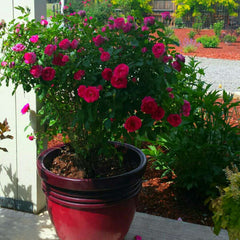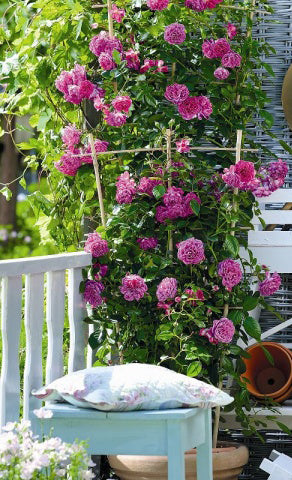Growing Rose Plants In Containers

Wild about roses? Limited on space? Don’t despair! You can still enjoy the beauty of rose plants by growing them in patio containers. Container gardening isn’t just for those short on space, you can bring the garden closer to your living spaces by adding roses to a patio or outdoor dining area, on a balcony or to line a front walkway. All that is required is ample sun, preferably 6 hours per day, in your growing location.
Select the correct rose
Look for roses that are reblooming or have a long bloom cycle and ones that tend to grow on the more compact side, ideally not reaching more than 2 feet in height. The taller the rose grows, the larger the container you will need. When planning a vignette of several containers select varieties with varying sizes and complimentary bloom colors.
For shrub roses look for floribundas, grandifloras or ground cover type roses. You can also grow climbing roses in larger containers with the aid of a trellis, either in the pot or anchored on a adjacent wall. Kordes Arborose varieties are bred to be grown in containers and perform well in tight locations. Climbing varieties include Honeymoon, Jasmina, Florentina and Quicksilver rose.
Choose the right container
 Your USDA Climate Zone will determine the container choices that are right for you. If you in USDA Zone 5 or colder you will want to select either wood, double walled plastic, fiberglass or high fired ceramic. All of these will provide some insulation to the plant over the winter and the container will hold up to the frost / freeze cycle.
Your USDA Climate Zone will determine the container choices that are right for you. If you in USDA Zone 5 or colder you will want to select either wood, double walled plastic, fiberglass or high fired ceramic. All of these will provide some insulation to the plant over the winter and the container will hold up to the frost / freeze cycle.
For zone 6 and warmer you can also use Terra Cotta, non-fired glazed ceramic, un-glazed ceramic, pottery and concrete. When choosing a container look for good drainage holes on the bottom. If the pot sits flat on the ground, use pot feet to elevate it for better drainage.
Rose planting tips
Use good quality potting soil that is made for container planting. Do not use manure products as these can burn the tips and roots of young plants if not properly composted. Plant the rose in the center of the pot and leave several inches at the top to accommodate water and mulch. Gently work in an organic slow release fertilizer around the base of the rose plant. Next apply a layer of bark mulch or recycled rubber mulch to retain moisture and discourage any weed growth.
Water on a regular basis, allowing the soil mix to just get slightly dry in between waterings. The amount and frequency of watering will depend on the temperature and season at your location. Remember that container plants dry out much faster than those in the garden, especially in the heat of summer.
Maintenance fertilization and pest control

Apply a liquid rose fertilizer throughout the growing season as your product indicates. Stop fertilizing 4-6 weeks before your first expected frost to discourage new, tender growth that can become frost-burned.
Establishing a preventative disease / pest control routine is just as important as fertilizing your new rose plant. I like to alternate weeks between liquid fertilization and pest / disease control. For mildew prevention I use GreenCure, an organic mildew treatment. For disease / pest control I use Azaguard. You can also use any of the Safer Brand products which are approved for organic growers and help to prevent aphids, whiteflies and other pests that can infest roses. Regardless of which pest / disease control method you use the most important thing is to use with regularity to prevent pest and diseases rather than trying to eliminate them.
Future container rose maintenance

Depending on the rose variety, you will find that after a year or two, the rose will use up most of the nutrients in the container and become root-bound, so you'll need to repot the rose. If you use the same container you will need to replace the soil. This is also a good time to move your plant into a larger pot or into a garden spot if possible.
If your container-grown rose is going to stay outside all year, and you live where the winters are cold, choose a variety rated at least two USDA Hardiness Zones colder than the one you're in. Use a weather-resistant container that won't crack in freezing weather. Make sure that you water your rose until it is completely dormant.
When the temperatures drop, put some extra mulch on top of the soil to help insulate the rose. Keep the mulch slightly away from the trunk and branches. For extra winter protection, place some mulch around the container itself. For cold weather gardeners read on for more in-depth tips on overwintering in pots.

